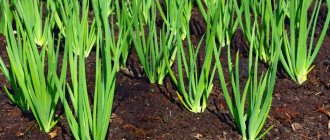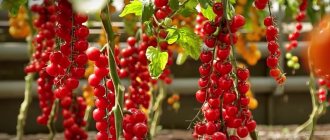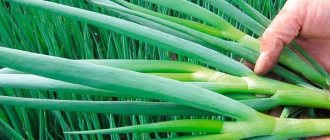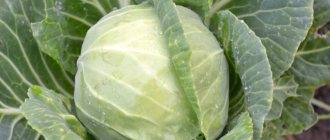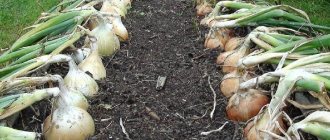Secrets of growing leeks in open ground from seeds and seedlings.
Just a couple of years ago, leeks were not very popular among housewives, and they used them for cooking only occasionally. But at the moment this product has become very popular and people began to consume it not only fresh, but also dried and pickled.
Of course, you can regularly eat leek only if you grow it yourself in your own garden bed. After all, if you buy it all year round in a store, then preparing the goodies will be expensive. Our article will tell you how to properly grow leeks from seeds.
What does a leek look like: photo
Leek: photo
Leek is a fairly tall green plant, which looks very different from the onion we are used to. It does not have a large rounded bottom. Or rather, it is there, but less pronounced and has an oblong rather than a round shape. A massive white stem emerges from the top of the false bulb. As a rule, its thickness is almost the same as the size of the false bulb. The stem ends in a fan-shaped bunch of long green leaves. You can see what leeks look like in the photo located a little higher.
Early and mid-early
Early varieties are well suited for the north of Russia, the Siberian and Ural regions. After all, there are very few warm months in this territory. The onions grown here are eaten fresh or canned.
Columbus
Columbus is one of those leek varieties suitable for cultivation that ripen early. It can be harvested approximately 85 days after sowing.
The advantage is its resistance to cold. The stem of this onion is quite tall. It reaches 70-80 cm. And the size of the white leg of a leek is about 20-30 cm.
If you provide the plant with normal care, it will delight you with a good weight of the bulb - up to 400 g. A special feature of the Columbus onion is that its stem is not “bleached” artificially, using hilling.
Vesta
This onion has a distinct semi-sharp and slightly sweet taste. It can be eaten fresh, dried, frozen, or added to canned food.
The Vesta variety is high-yielding; it easily tolerates disease, cold and heat, but only if you feed it well. If you plant onions in a temperate climate zone, you need to do this using seedlings. The height of the stems, in this case, reaches 1.5 meters. The light stem sometimes reaches 0.5 m in length if it is regularly hilled. At the same time, the bulb itself is quite small.
Elephant's trunk
This type of onion is suitable for areas with low to moderate temperatures and is grown using seedlings. It should be planted in the last winter month. And after 2-2.5 months, the onions are transferred to the soil.
If you decide to plant this onion in the southern region of Russia, you don’t have to use seedlings. The onion leg grows up to 30 cm under the conditions that it is properly cared for.
The fruits taste quite pleasant, they are sweetish. This variety is stored for a long time and can stand in the sand for several months.
Tango
This variety tastes a little spicy and pleasant. It is suitable for preparing a wide variety of dishes. It can be eaten fresh, dried or canned.
"Tango" is a relatively early, high-yielding variety. After about 4 months from the moment of sowing, you will be able to harvest.
The stem of this variety is small. The height of its light part is about 15 cm. And its thickness is approximately 5 cm. The weight of the bulb reaches 200 grams. The height of the leaves is approximately 70 cm, they are dark green with a bluish tint.
“Tango” calmly tolerates frosts, it is not afraid of diseases, fungi and parasites. It can be stored for a long time.
Goliath
This variety is relatively early - you can start harvesting 4 months later, in July.
This variety brings a large harvest. It is quite tall - the light part reaches approximately 25-28 cm. The diameter of the stem is about 5 centimeters. And the weight of the bulb is about 200 grams. Its foliage is medium in size and gray-green in color.
The variety is often susceptible to disease and needs to be cared for very carefully. Columbus tastes pretty good. It can be eaten fresh, dried or canned.
Kilima
This variety matures in approximately 5 months. Already in July you can harvest. Its light part is extended approximately 25 cm upward and its width is about 5 cm.
Shelton
This is a hybrid that matures in up to three and a half months. Already in June and July you can start harvesting. Anyone can eat it.
Treatment of leek seeds before planting: description
Experienced gardeners know that absolutely all seeds need to be prepared for sowing in a way that promotes faster germination and rooting. Leek seeds are no exception and are also best prepared properly.
So:
- First, boil the water and then cool it to 45 degrees
- Place the seeds in a piece of gauze, tie it into a kind of bag and lower it into warm water for 25 minutes.
- After this, dip the seeds in cool water and place them on a damp cloth.
- Cover them with another piece of cloth and leave them alone for 3-5 days.
- Don't forget to periodically moisten the fabric with a spray bottle.
- After the specified time, the seeds will be ready for sowing
- If desired, you can additionally treat them with growth stimulants and disinfect them in a weak solution of potassium permanganate
